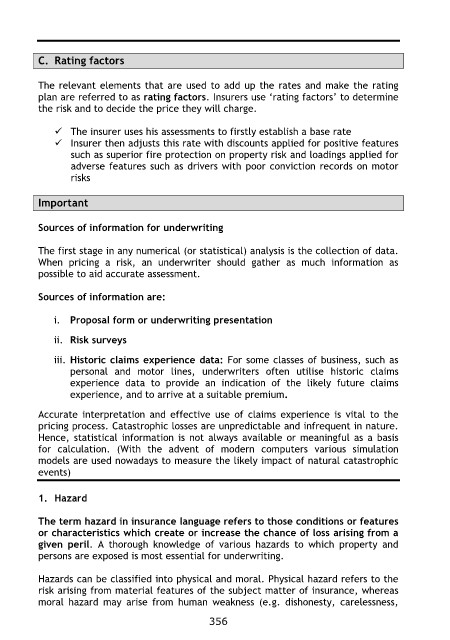Page 362 - IC38 GENERAL INSURANCE
P. 362
C. Rating factors
The relevant elements that are used to add up the rates and make the rating
plan are referred to as rating factors. Insurers use „rating factors‟ to determine
the risk and to decide the price they will charge.
The insurer uses his assessments to firstly establish a base rate
Insurer then adjusts this rate with discounts applied for positive features
such as superior fire protection on property risk and loadings applied for
adverse features such as drivers with poor conviction records on motor
risks
Important
Sources of information for underwriting
The first stage in any numerical (or statistical) analysis is the collection of data.
When pricing a risk, an underwriter should gather as much information as
possible to aid accurate assessment.
Sources of information are:
i. Proposal form or underwriting presentation
ii. Risk surveys
iii. Historic claims experience data: For some classes of business, such as
personal and motor lines, underwriters often utilise historic claims
experience data to provide an indication of the likely future claims
experience, and to arrive at a suitable premium.
Accurate interpretation and effective use of claims experience is vital to the
pricing process. Catastrophic losses are unpredictable and infrequent in nature.
Hence, statistical information is not always available or meaningful as a basis
for calculation. (With the advent of modern computers various simulation
models are used nowadays to measure the likely impact of natural catastrophic
events)
1. Hazard
The term hazard in insurance language refers to those conditions or features
or characteristics which create or increase the chance of loss arising from a
given peril. A thorough knowledge of various hazards to which property and
persons are exposed is most essential for underwriting.
Hazards can be classified into physical and moral. Physical hazard refers to the
risk arising from material features of the subject matter of insurance, whereas
moral hazard may arise from human weakness (e.g. dishonesty, carelessness,
356

